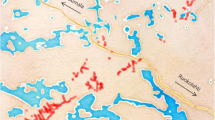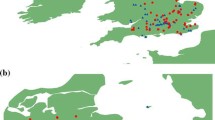Abstract
Several hypotheses have been proposed to explain the mechanisms responsible for maintenance of host-specific gentes in the common cuckoo (Cuculus canorus). Some of them expect that when adult cuckoos return to lay their eggs to their natal site (natal philopatry hypothesis) or habitat in which they were reared (habitat-imprinting hypothesis), there is a higher probability of finding nests of the host species by which they were reared. Since published evidence is ambiguous, we here evaluate the natal philopatry and habitat-imprinting hypotheses using information on habitat homogeneity and cross-continental long-term ringing data. We found no evidence for the natal philopatry hypothesis—instead of returning to their natal site, juvenile cuckoos exhibited longer dispersal movements than adults, and the difference was even larger in comparison with a wide array of cuckoo host species. On the contrary, we found support for the habitat-imprinting hypothesis—juvenile cuckoos followed similar levels of natal habitat homogeneity at 5- and 25-km scale when returning to breed in the next years. Our results suggest that preference for the particular habitat structures may help cuckoos to find appropriate hosts.

Similar content being viewed by others
Data availability
The data that support the findings of this study are available from EURING. Restrictions apply to the availability of these data, which were used under licence for this study. Data are available from the authors with the permission of EURING.
References
Bartoń K (2016) MuMIn: multi-model inference. R package ver. 1.15.6. https://CRAN.R-project.org/package=MuMIn. Accessed 26 June 2019
Brooke M, Davies NB (1991) A failure to demonstrate host imprinting in the cuckoo (Cuculus canorus) and alternative hypotheses for the maintenance of egg mimicry. Ethology 89:154–166. https://doi.org/10.1111/j.1439-0310.1991.tb00301.x
Burnham KP, Anderson DR (2002) Model selection and multimodel inference. Springer, New York
Campobello D, Sealy SG (2009) Avian brood parasitism in a Mediterranean region: hosts and habitat preferences of common cuckoos Cuculus canorus. Bird Study 56:389–400. https://doi.org/10.1080/00063650903013221
Chance EP (1940) The truth about the cuckoo. Country Life, London
Cramp S (1985) The birds of the Western Palearctic, vol IV. Oxford University Press, New York
Dormann CF, Elith J, Bacher S, Buchmann C, Carl G, Carré G, García Marquéz JM, Gruber B, Lafourcade B, Leitão PJ, Münkemüller T, McClean C, Osborne PE, Reineking B, Schröder B, Skidmore AK, Zurell D, Lautenbach S (2013) Collinearity: a review of methods to deal with it and a simulation study evaluating their performance. Ecography 36:27–46. https://doi.org/10.1111/j.1600-0587.2012.07348.x
du Feu CR, Joys AC, Clark JA, Fiedler W, Downie IS, van Noordwijk AJ, Spina F, Wassenaar R, Baillie SR (2009) EURING Data Bank geographical index 2009. https://www.euring.org/data-and-codes/euring-databank-index. Accessed 8 November 2018
Erritzøe J, Mann CF, Brammer FP, Fuller RA (2012) Cuckoos of the world – Helm Identification Guide. Christopher Helm, London
Greenwood PJ, Harvey PH (1982) The natal and breeding dispersal of birds. Annu Rev Ecol Syst 13:1–21. https://doi.org/10.1146/annurev.es.13.110182.000245
Grueber CE, Nakagawa S, Laws RJ, Jamieson IG (2011) Multimodel inference in ecology and evolution: challenges and solutions. J Evol Biol 24:699–711. https://doi.org/10.1111/j.1420-9101.2010.02210.x
Honza M, Moksnes A, Røskaft E, Stokke BG (2001) How are different common cuckoo Cuculus canorus egg morphs maintained? An evaluation of different hypotheses. Ardea 89:341–352
Honza M, Taborsky B, Taborsky M, Teuschl Y, Vogl W, Moksnes A, Røskaft E (2002) Behaviour of female common cuckoos, Cuculus canorus, in the vicinity of host nests before and during egg laying: a radiotelemetry study. Anim Behav 64:861–868. https://doi.org/10.1006/anbe.2002.1969
Honza M, Šulc M, Jelínek V, Požgayová M, Procházka P (2014) Brood parasites lay eggs matching the appearance of host clutches. Proc R Soc Lond B Biol Sci 281:20132665. https://doi.org/10.1098/rspb.2013.2665
Johnson JB, Omland KS (2004) Model selection in ecology and evolution. Trends Ecol Evol 19:101–108. https://doi.org/10.1016/j.tree.2003.10.013
Kolářová E, Adamík P (2015) Bird arrival dates in Central Europe based on one of the earliest phenological networks. Clim Res 63:91–98. https://doi.org/10.3354/cr01290
Korner-Nievergelt F, Robinson R (2015) birdring: methods to analyse ring re-encounter data. R package ver. 1.3. https://CRAN.R-project.org/package=birdring. Accessed 26 June 2019
Korner-Nievergelt F, Sauter A, Atkinson PW, Guélat J, Kania W, Kéry M, Köppen U, Robinson RA, Schaub M, Thorup K, van der Jeugd H, van Noordwijk AJ (2010) Improving the analysis of movement data from marked individuals through explicit estimation of observer heterogeneity. J Avian Biol 41:8–17. https://doi.org/10.1111/j.1600-048X.2009.04907.x
Lack D (1968) Ecological adaptations for breeding in birds. Methuen, London
Moksnes A, Røskaft E (1989) Adaptations of meadow pipits to parasitism by the common cuckoo. Behav Ecol Sociobiol 24:25–30. https://doi.org/10.1007/BF00300114
Moksnes A, Røskaft E (1995) Egg-morphs and host preference in the common cuckoo (Cuculus canorus): an analysis of cuckoo and host eggs from European museum collections. J Zool 236:625–648. https://doi.org/10.1111/j.1469-7998.1995.tb02736.x
Morelli F, Jiguet F, Reif J, Plexida S, Suzi Valli A, Indykiewicz P, Šímová P, Tichit M, Moretti M, Tryjanowski P (2015) Cuckoo and biodiversity: testing the correlation between species occurrence and bird species richness in Europe. Biol Conserv 190:123–132. https://doi.org/10.1016/j.biocon.2015.06.003
Moskát C, Bán M, Fülöp A, Bereczki J, Hauber ME (2019) Bimodal habitat use in brood parasitic common cuckoos (Cuculus canorus) revealed by GPS telemetry. Auk 136:1–12. https://doi.org/10.1093/auk/uky019
Newton A (1893) A dictionary of birds. Part 1. Black, London
Paradis E, Baillie SR, Sutherland WJ, Gregory RD (1998) Patterns of natal and breeding dispersal in birds. J Anim Ecol 67:518–536. https://doi.org/10.1046/j.1365-2656.1998.00215.x
R Core Team (2017) R: a language and environment for statistical computing. R Foundation for Statistical Computing, Vienna
Saino N, Rubolini D, Lehikoinen E, Sokolov LV, Bonisoli-Alquati A, Ambrosini R, Boncoraglio G, Møller AP (2009) Climate change effects on migration phenology may mismatch brood parasitic cuckoos and their hosts. Biol Lett 5:539–541. https://doi.org/10.1098/rsbl.2009.0312
Samaš P, Rutila J, Grim T (2016) The common redstart as a suitable model to study cuckoo-host coevolution in a unique ecological context. BMC Evol Biol 16:255–213. https://doi.org/10.1186/s12862-016-0835-5
Seel DC (1977) Migration of the northwestern European population of the cuckoo Cuculus canorus, as shown by ringing. Ibis 119:309–322. https://doi.org/10.1111/j.1474-919X.1977.tb08250.x
Stokke BG, Hafstad I, Rudolfsen G, Bargain B, Beier J, Bigas Campàs D, Dyrcz A, Honza M, Leisler B, Pap PL, Patapavičius R, Procházka P, Schulze-Hagen K, Thomas R, Moksnes A, Møller AP, Røskaft E, Soler M (2007) Host density predicts presence of cuckoo parasitism in reed warblers. Oikos 116:913–922. https://doi.org/10.1111/j.0030-1299.2007.15832.x
Teuschl Y, Taborsky B, Taborsky M (1994) Habitat imprinting and egg mimicry in European cuckoos. J Ornithol 135:137–137. https://doi.org/10.1007/BF02445763
Teuschl Y, Taborsky B, Taborsky M (1998) How do cuckoos find their hosts? The role of habitat imprinting. Anim Behav 56:1425–1433. https://doi.org/10.1006/anbe.1998.0931
Tobler W, Deichmann V, Gottsegen J, Maloy K (1995) The global demography project. Technical report TR-95-6. National Center for geographic information analysis. University of Santa Barbara
Tuanmu MN, Jetz W (2015) A global, remote sensing-based characterization of terrestrial habitat heterogeneity for biodiversity and ecosystem modelling. Glob Ecol Biogeogr 24:1329–1339. https://doi.org/10.1111/geb.12365
Vogl W, Taborsky M, Taborsky B, Teuschl Y, Honza M (2002) Cuckoo females preferentially use specific habitats when searching for host nests. Anim Behav 64:843–850. https://doi.org/10.1006/anbe.2003.1967
Vogl W, Taborsky B, Taborsky M, Teuschl Y, Honza M (2004) Habitat and space use of European cuckoo females during the egg laying period. Behaviour 141:881–898. https://doi.org/10.1163/1568539042265671
Williams HM, Willemoes M, Klaassen RH, Strandberg R, Thorup K (2016) Common cuckoo home ranges are larger in the breeding season than in the non-breeding season and in regions of sparse forest cover. J Ornithol 157:461–469. https://doi.org/10.1007/s10336-015-1308-0
Wyllie I (1981) The cuckoo. Batsford, London
Zuur AF, Ieno EN, Elphick CS (2010) A protocol for data exploration to avoid common statistical problems. Methods Ecol Evol 1:3–14. https://doi.org/10.1111/j.2041-210X.2009.00001.x
Acknowledgements
We are grateful to the European Union for Bird Ringing (EURING) which made the recovery data available through the EURING Data Bank and to the many ringers and ringing scheme staff who have gathered and prepared the data. Wesley Hochachka and two anonymous reviewers provided valuable comments.
Funding
This study was supported by the Czech Science Foundation (project 17-12262S) and by the Institutional Research Plan (RVO: 68081766).
Author information
Authors and Affiliations
Corresponding author
Ethics declarations
Conflict of interest
The authors declare that they have no conflict of interest.
Additional information
Communicated by: Matthias Waltert
Publisher’s note
Springer Nature remains neutral with regard to jurisdictional claims in published maps and institutional affiliations.
Rights and permissions
About this article
Cite this article
Koleček, J., Procházka, P., Brlík, V. et al. Cross-continental test of natal philopatry and habitat-imprinting hypotheses to explain host specificity in an obligate brood parasite. Sci Nat 107, 12 (2020). https://doi.org/10.1007/s00114-020-1667-0
Received:
Revised:
Accepted:
Published:
DOI: https://doi.org/10.1007/s00114-020-1667-0




